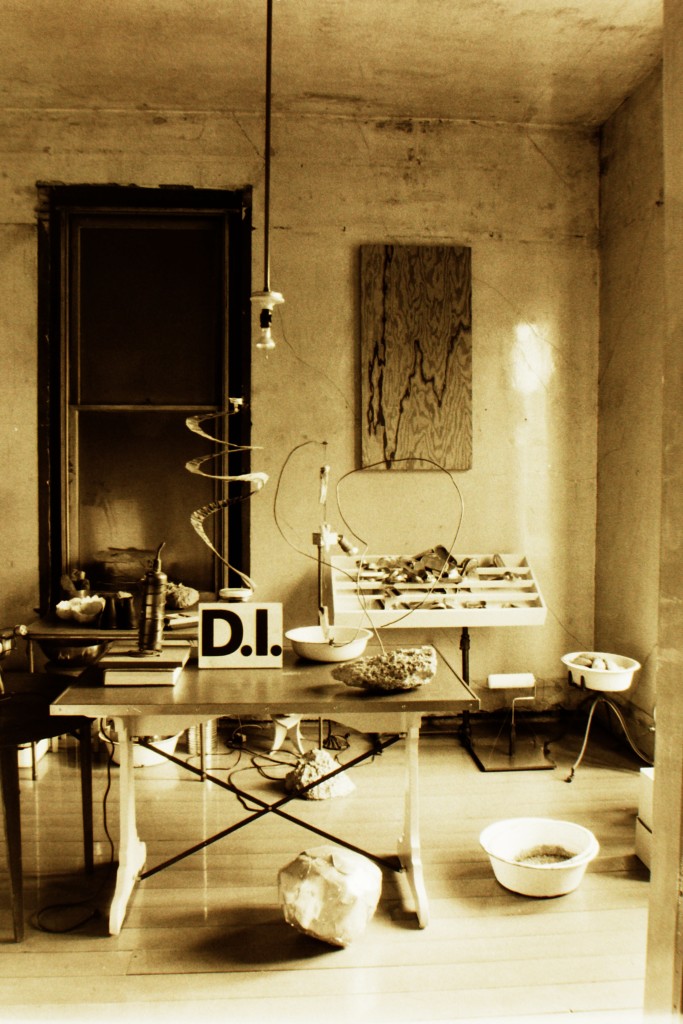David + 500 Capp Street House

Ireland’s residence at 500 Capp Street in San Francisco’s Mission District is widely considered the centerpiece of his prolific career. During the three decades he lived in the house, he embedded it with art and slowly evolved it into a site-specific installation that’s now regarded as the inspiration, source of materials, and repository for some of his most important work of the 1980s and 1990s.
Upon returning to San Francisco in the 1970s to settle down, Ireland purchased the dilapidated Italianate-style home and began implementing what he referred to as a 30-month “maintenance action”: removing window moldings, stripping wallpaper, sanding surfaces, and finally coating the walls, ceiling, and floors with high-gloss polyurethane varnish to preserve and highlight his modifications. His original intent was to clear out the house and use it as studio, but he soon grew to see the home in a sculptural way, perceiving his activity as an artistic endeavor more than a simple architectural renovation.
“I reached a philosophical point where I realized that the lively presence I was looking for in my art was here on the walls, as I stripped away and cleaned off the surfaces,” Ireland explained in a 1981 interview. “Why do we have to fabricate a stretcher, a canvas—why not just make art out of an environment? I couldn’t go back to normal work.”
Ireland’s art and life are so interwoven in the house that it’s difficult to distinguish between the art and non-art—distinctions irrelevant to him who, like many of his conceptual-art peers, sought to deliberately confuse these boundaries.
The House and its interventions showcase Ireland’s signature use of everyday materials and his rich sense of humor.
Some examples include:
Installations that are part of the architecture, such as Untitled (The View from This Window, circa 1979), a window that Ireland removed and masked over with a copper plate. The work includes a recording of the artist’s voice describing the obscured view.
Pieces that document Ireland’s removal of items left behind by the previous owner, including a heavy safe: two bronze wall plaques along the stairwell describe moving mishaps that caused substantial gouges in the plaster (The Safe Gets Away for the First Time November 5, 1975; and The Safe Gets Away for the Second Time November 5, 1975).
Ireland also made round “patties” of stripped wallpaper (Untitled, circa 1978)—inspired by the dung patties he saw used for fuel on his travels in Asia—and applied them in the upstairs hallways, running vertically like peas in a pod.
Works that give new life to objects left behind by the previous owner by refashioning them into sculptures, including Three-Legged Chair (1978), a non-functional chair with one of the legs sawed off. The work includes an attached notebook containing parallel narratives about the chair’s meaning and history that conflate fact and fiction.
Explorations of light reflection in the home, most dramatically achieved by applying multiple coats of clear polyurethane to the signature saffron-colored interior walls. This final touch not only sealed the cracks and preserved the visible history of changes to surfaces, but also created a luminous sheen and highlighted every nuance of the architecture.
A kinetic and slightly unnerving chandelier made from two blowtorches suspended from the ceiling on wires (Fire Drawing,d.)—just one of the house’s eccentric, artist-made light fixtures—is a highlight of the upstairs parlor.
Artist-made furniture and an array of eclectic found objects, including animal skulls and African woodcarvings, as well as combines such as Untitled (Water Buffalo), 1995, and Three Wheeler, circa 1979—pieces fashioned from relics of Ireland early safari experiences.

